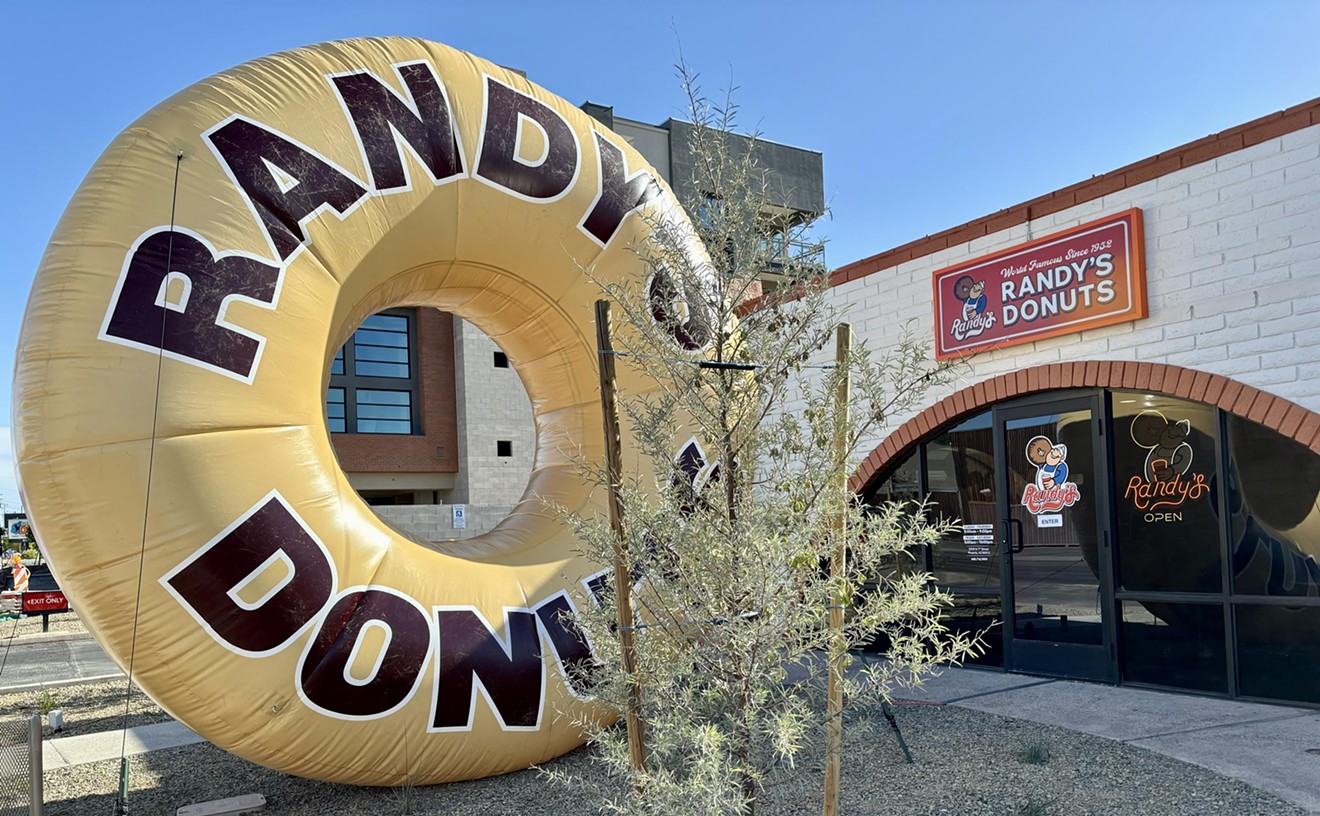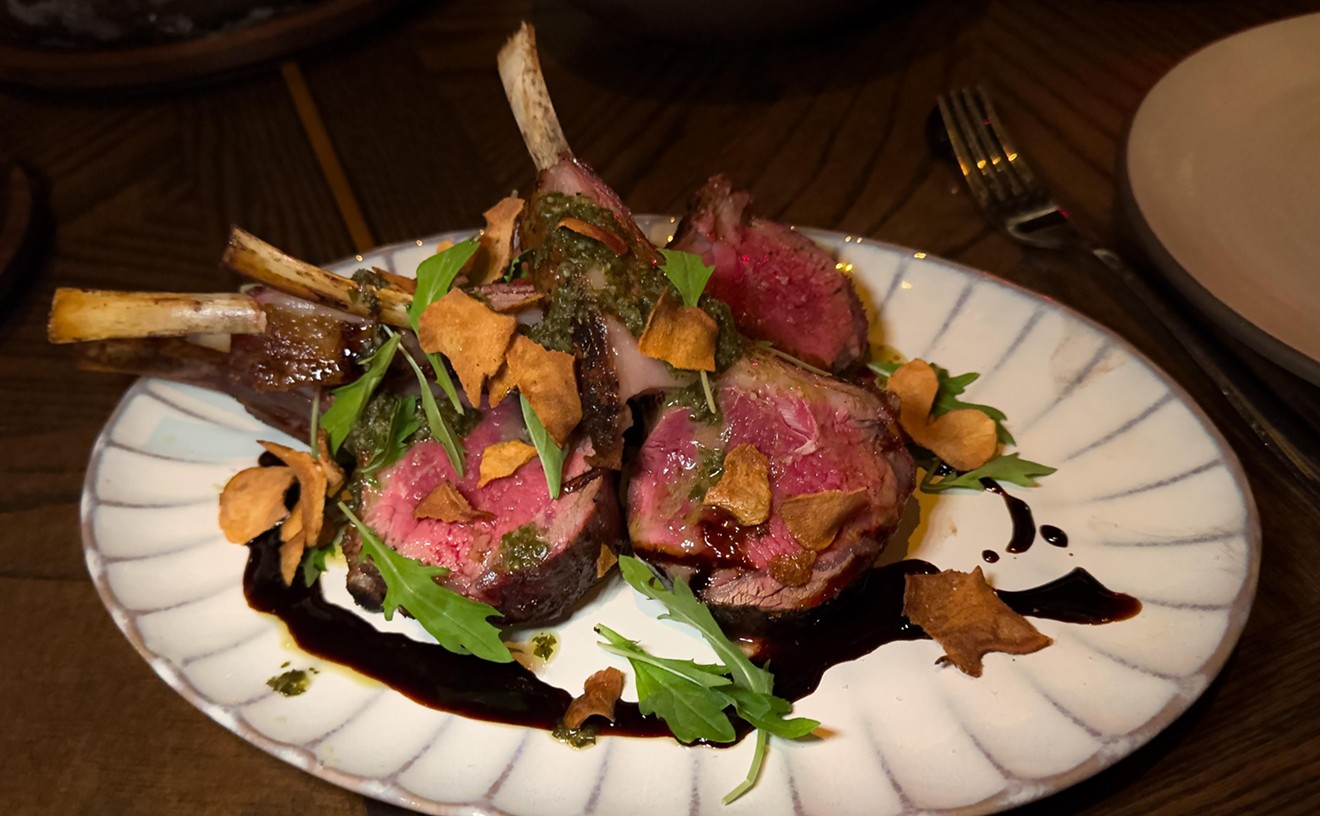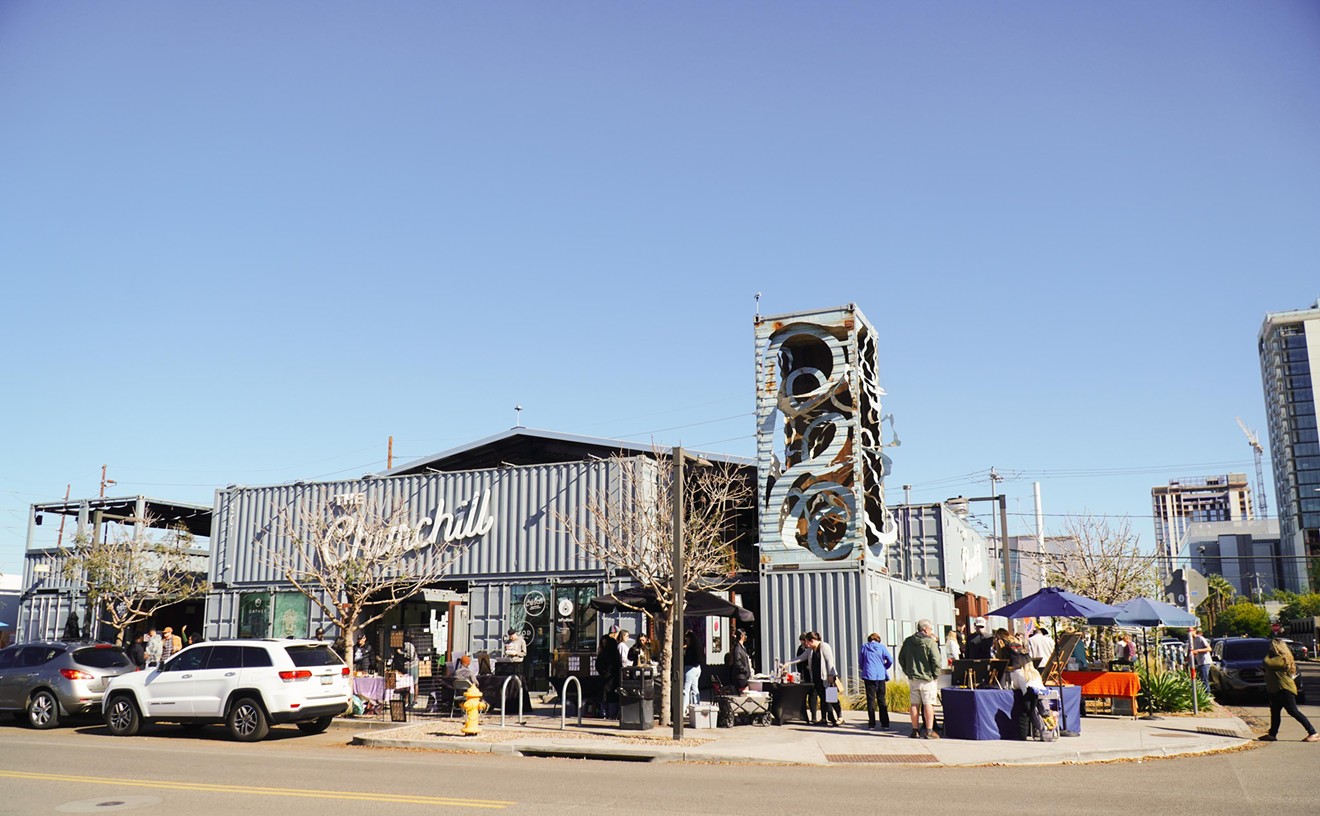Welcome to Sonoran Arcana, a column seeking to probe the margins of Arizona cuisine and define a more specific, novel cuisine that has emerged in America's great Sonoran Desert, New Arizonan. Here, we will venture into the arid wilds and culinary unknown to spotlight the chefs and foragers, the millers and brewers, the miso masters and palo verde pod pickers who are pioneering New Arizonan cuisine, or simply rocking out the food of Arizona. So throw open the doors to your mind and enjoy.
Chase Saraiva has to drive like a desert turtle. Hitched to his truck are twin 350-gallon tanks sloshing cooked-grain liquid. He woke up at 3:45 in the morning to make the grain liquid, called wort, from 400 pounds of Arizona malt and 300 pounds of White Sonora Wheat. Now, 13 hours later, Saraiva is crawling east across Highway 60 from Gilbert’s Arizona Wilderness Brewing Company, where he is head brewer. Too abrupt a movement could spill a tank, cutting short the long night coming.
Beer equals wort plus yeast and time. And yet Saraiva, who gets paid to artfully navigate this equation, is moving wort away from his Gilbert digs stocked with select yeast. That’s because Arizona Wilderness is a brewery that lives up to its name: Saraiva is about to make beer in the wild.
He passes through Superior. He enters Elm Canyon, the road slicing. High above, a black dot appears like a daytime star: a drone.
A few miles away, Jonathan Buford sips his own craft lager. “How many drones you seen get a coolship coming through a canyon?” he asks a group of brewers, his brown beard flowing down his torso. Buford — who owns Arizona Wilderness with Patrick Ware, a man with eyes like X-rays and an eerily similar desert-island beard — watches the brewery’s videographer. The video guru stands by a pond with a remote control, capturing drone footage of Saraiva’s approach.
Methodically, Saraiva pilots his mobile brewing unit off the highway. When he parks by the pond mirroring the sky, Coolship 8 begins.
Since opening in 2013, Arizona Wilderness has pioneered the Valley’s beer scene, pushing what people can drink in Arizona into funky, woody, sour, strange, beautiful, atmospheric territory. Buford, Ware, and Saraiva produce thoughtful, dependable versions of beer styles widely popular in America (like IPA and lager), and do so heavily using grain, fruit, and other inputs from local farms.
But what sets Wilderness apart is its YOLO moonshot projects. Foeders. Mixed-style beers. Beer-wine hybrids. Brewing with foraged materials like spruce and sycamore bark. And most of all, the biannual coolship project, a pluperfect distillation of this brewery’s local ethos and madcap style.
Even as most breweries have chased trends — hazy IPAs, pastry stouts, adjuncts like juice — Wilderness has moved mostly in the other direction, toward the eternal.
“It’s definitely a romantic gesture,” says Wilderness "wood brewer" Luke Wortendyke, of the coolship project. “This style of brewing was around before industrialization, before we knew scientifically what yeast was, before Pasteur discovered that.”
Like the ancient Egyptians, like the Campanian vintners recalled by Pliny the Elder, Wilderness will be catalyzing fermentation using ambient microbes, tiny yeasts floating around in the air. The idea of a fermentation in the wild came to Ware and Buford when backpacking. Looking to haul apples out of the wilderness, they were seized by an urge to leave pressed apple juice in the woods to ferment naturally for a year, but the obstacles were too many: elements, heat, people, animals. So they decided to inoculate wort in the wild, then let it ferment in the brewery.
As 100 percent ambient yeasts will be used, fermentation will be “spontaneous," and the beer a "wild ale." Without a prepackaged or otherwise tightly controlled yeast, brewers have limited leverage over how flavor will change, sour, funk, wander.
Parked, Saraiva emerges. On the hitched flatbed, two square steel tanks flank a shallow pan. The shallow pan is a coolship.
“Before the advent of refrigeration and chilled water,” reads The Oxford Companion to Beer, “hot wort was cooled by transfer to these shallow, open vessels, where the wort was allowed to cool slowly.” Unseen, wort sloshes in the coolship as Saraiva steps over. More than a dozen brewers visiting from places like Carmel and Toronto draw in close.
After greeting people, Saraiva, who looks like a young chemistry professor, lifts a tank's hose. He holds it over the shallow pan.
Liquid like milky chai gushes out. It spreads thinly across the shallow pan. A smell of pretzel — freshly baked pretzel — diffuses with the wort. Jonathan Buford, wearing a brown jacket with prancing ponies, strums a guitar and sings improvised songs about wort and brewing. Gnats arc through the sunlight, bobbing and flitting erratically, randomly. Invisibly, so do tiny yeasts. Wort steadily climbs the sides of the 130-gallon coolship, bubbling madly and soapily, wisping steam.
Talented brewers sip beer, watch, talk shop. Saraiva hands off the hose so others can pour.
“What we’re doing today is an exploration of, and an extension of, the philosophies Jon and Pat have ingrained in the business,” Saraiva says. “Just trying to see what’s out there, microbially in the Arizona wilderness. You know, we work with a lot of foraged ingredients. This is an extension of that.”
Since 2016, when the project started, Wilderness has toted two versions of its mobile coolship into the wild a total of eight times. Each time, they went to a new place. Because these fermentations take so long, only two of the eight beers have been released.
The first coolship, sparked to life in the Kachina Peaks, was “puckeringly sour” according to Ware.
The second, inoculated in the woods near Flagstaff, brings a less potent sourness sculpted by wood and barnyard funk. It almost tastes like Basque sidra, a funky style of Spanish cider. This second vintage, Coolship 2, was released the night before Coolship 8 began its life beside the glassy pond in the Oak Flat manzanita woods.
“Personally, as a brewer, this is one of the coolest things I’ve ever done,” Wortendyke says.
“They’re very complex,” Wilderness brewer Ashley Benson says. “The last two had olive notes and things you wouldn’t necessarily think to think of in beer.”
“Everyone stares into the wort and says, ‘This is fucking cool,’” Buford says. “Then the libations happen all night and it’s incredible.”
“It’s still a bit of a roll of the die, a crap shoot, for what you’re going to get,” Saraiva says.
“Ultimately, it’s a 25-year project before you’re going to get a grasp on it,” says Ware, who wants to keep coolship vintages for side-by-side tasting in future years. “I think that we as people, we need something to look forward to in this world. If you just do the same thing every day, you just drone on and get bored.”
Now that Wilderness is four years in, has released two Coolship vintages, and has been tasting the others as they glacially ferment, the brewers know how to temper flavor. For vintage eight, they are using wort with long carbohydrate chains, ample nutrition to keep yeasts healthy during a marathon fermentation. They are also using aged hops, which, because their alpha acid content has diminished, will layer the beer with a different kind of bitterness (while still retaining hops' preservative powers — what attracted early brewers to hops in the first place).
Logistics. Memory. Weather. Humidity. Cool temperatures at night. There are many obstacles to brewing a wild ale in the wild. The mightiest is time. An Arizona Wilderness Coolship beer takes one to three years to ferment. This is liquid magic at the speed of continental drift. The project takes on more gravity in light of the fact that, through a process called kettle-souring, brewers can make sour beer in days.
Coolship beers and other wild ales are different.
“At the end,” Saraiva says, “once the fermentation is complete, which could be one, two, three years, you have a complex product that isn’t just kind of a monoculture you can make in two weeks.”
There are layers to why Wilderness does a spontaneous fermentation in the woods rather than flashbang kettle-souring.
First, the resulting beer will be imbued with deep strata of flavor, almost like a wine, though nobody knows what those flavors will be (beyond tart, as wild ales tend to sour).
Second, there is the connection to preindustrial brewing methods of the recent and remote past. Long ago, before stainless steel, people brewed using wooden vessels. People also lacked refrigeration and were at the mercy of weather: cooling wort at night in shallow vessels, brewing during seasons when the highs and humidity were right.
Third, there is the element that is as utterly uncontrollable, like a Sonoran haboob or winter constellation: the wild yeast. And this is where the project — undertaken by just a few other breweries in the country, similar to the old Belgian coolship tradition but teleported to the Arizona wilderness — gets really interesting.
“I think it captures a specific time and place,” Saraiva says, of culling wild yeasts and bacteria from the wilderness. “Because what’s in the air right now isn’t going to be what’s in it tomorrow, three hours from now, four hours, or three years from now. It’s capturing the here and now.”
This is why Wilderness does each Coolship vintage in a new place.
This is why they gather microbes from Ponderosa pine forests, fields with fallen prickly pear fruit, clearings by glassy ponds in manzanita woods.
This is why they repeat the project biannually, year after year: to log liquid snapshots of Arizona’s unique wild spaces.
Using wild yeasts forges a fleeting connection to an elusive present, to a concrete here and now. Wild microbes in the air change. They change rapidly: from place to place, from day to day, by the plants and animals and seasons and clouds and wind gusts and raindrops and guitar players and human activity in the woods. When Saraiva uses ambient microbes to catalyze fermentation, he is using microbes ephemerally alive in a time and place of Arizona that the world will never know again. He is locking that time and place into a bottle, writing its spirit into a beer.
So what, then, will he be locking into Coolship 8?
Once the coolship fills, the day’s work is finished. Wort stays out. Microbes enter on their own. (“Over the course of the night, the winds and trees kind of release different bacteria and wild yeast strains and get carried by the wind and land on the wort,” Saraiva says.)
The brewers migrate to the lawn chairs by the bonfire and a long white tent. Jammy music and twangy country blast from Ware’s truck. Dogs rush into the pond. Craft libations are consumed at a rapid clip, and now and then a brewer saunters over the wort, studies his or her reflection.
Ware passes around an experimental beer-wine hybrid. There are pastry stouts, double IPAs, helles, lagers, sours. Dusk falls. The white spotlight of a nearby camp sears the giant night. A portable grill throws the scent and sizzle of charring meat over to the campfire. Stars punch through the inky veil. Voices grow louder. Yeasts float onto cooling wort.
After midnight, rain starts to fall. Saraiva lets some collect, then covers the wort with a tarp.
In the morning, the tents are slick. The coolship has been uncovered, and Saraiva is off handling a carbon dioxide tank, soon to pump the wort back into the steel tanks. “Um, so yeah, we got some rain last night,” he laughs. “You know, the rain can help bring minerals into it, and potentially pull some other different types of microbes from the air.”
Ware simmers coffee for the brewers, who trance out before a morning campfire ravaging dry antlers of manzanita.
“Extra yield,” Ware says about the rain, aloud to himself.
He flicks spent coffee grounds into the fire, grinning. “Microflora falling from the sky.”
Camp later breaks. Saraiva guides the mobile coolship back to the highway. Later, he’ll move the wort to 500-liter French oak puncheons. And there in the dark, wild yeasts will awaken four days later to work their ancient magic, alchemy that will last up to three years, when, upon release, the vanished time and place of Coolship 8 will rise to life again.
Arizona Wilderness Brewing Company. 721 North Arizona Avenue, Gilbert; 480-497-2739.
Monday to Thursday 11 a.m. to 11 p.m.; Friday and Saturday 11 a.m. to midnight; Sunday 11 a.m. to 10 p.m.
Arizona Wilderness Brewing Co. Downtown Phoenix Beer Garden. 201 East Roosevelt Street; 480-462-1836.
Monday to Wednesday 11 a.m. to midnight; Thursday to Sunday 11 to 2 a.m.
[
{
"name": "Air - MediumRectangle - Inline Content - Mobile Display Size",
"component": "18478561",
"insertPoint": "2",
"requiredCountToDisplay": "2"
},{
"name": "Editor Picks",
"component": "16759093",
"insertPoint": "4",
"requiredCountToDisplay": "1"
},{
"name": "Inline Links",
"component": "17980324",
"insertPoint": "8th",
"startingPoint": 8,
"requiredCountToDisplay": "7",
"maxInsertions": 25
},{
"name": "Air - MediumRectangle - Combo - Inline Content",
"component": "16759092",
"insertPoint": "8th",
"startingPoint": 8,
"requiredCountToDisplay": "7",
"maxInsertions": 25
},{
"name": "Inline Links",
"component": "17980324",
"insertPoint": "8th",
"startingPoint": 12,
"requiredCountToDisplay": "11",
"maxInsertions": 24
},{
"name": "Air - Leaderboard Tower - Combo - Inline Content",
"component": "16759094",
"insertPoint": "8th",
"startingPoint": 12,
"requiredCountToDisplay": "11",
"maxInsertions": 24
}
]
















